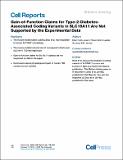| dc.contributor.author | Lander, Eric S. | |
| dc.date.accessioned | 2020-05-13T13:25:29Z | |
| dc.date.available | 2020-05-13T13:25:29Z | |
| dc.date.issued | 2019-10 | |
| dc.identifier.issn | 2211-1247 | |
| dc.identifier.uri | https://hdl.handle.net/1721.1/125204 | |
| dc.description.abstract | Human genetic variants inSLC16A11are associatedwith increased risk of type 2 diabetes (T2D). We pre-viously identified two distinct mechanisms throughwhich co-inherited T2D-risk coding and non-codingvariants disruptSLC16A11expression and activity,thus implicating reduced SLC16A11 function as thedisease-relevant direction of effect. In a recent pub-lication,Zhao et al. (2019a)argue that humanSLC16A11 coding variants confer gain of function,basing their conclusions on phenotypic changesobserved following overexpression of mutant murineSlc16a11. However, data necessary to demonstrategain-of-function activity are not reported. Further-more, several fundamental flaws in their experi-mental system—including inaccurate modeling ofthe human variant haplotype and expression condi-tions that are not physiologically relevant—preventconclusions about T2D-risk variant effects on humanphysiology. This Matters Arising paper is in response toZhao et al. (2019a), published inCell Reports. Seealso the response byZhao et al. (2019b)in this issueofCell Reports. | en_US |
| dc.language.iso | en | |
| dc.publisher | Elsevier BV | en_US |
| dc.relation.isversionof | 10.1016/j.celrep.2019.09.021 | en_US |
| dc.rights | Creative Commons Attribution 4.0 International license | en_US |
| dc.rights.uri | https://creativecommons.org/licenses/by/4.0/ | en_US |
| dc.source | Elsevier | en_US |
| dc.title | Gain-of-Function Claims for Type-2-Diabetes-Associated Coding Variants in SLC16A11 Are Not Supported by the Experimental Data | en_US |
| dc.type | Article | en_US |
| dc.identifier.citation | Hoch, Eitan et al. “Gain-of-Function Claims for Type-2-Diabetes-Associated Coding Variants in SLC16A11 Are Not Supported by the Experimental Data.” Cell reports 29 (2019): 778-780 © 2019 The Author(s) | en_US |
| dc.contributor.department | Massachusetts Institute of Technology. Department of Biology | en_US |
| dc.relation.journal | Cell reports | en_US |
| dc.eprint.version | Final published version | en_US |
| dc.type.uri | http://purl.org/eprint/type/JournalArticle | en_US |
| eprint.status | http://purl.org/eprint/status/PeerReviewed | en_US |
| dc.date.updated | 2020-01-22T19:04:31Z | |
| dspace.date.submission | 2020-01-22T19:04:33Z | |
| mit.journal.volume | 29 | en_US |
| mit.metadata.status | Complete | |
